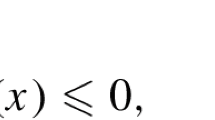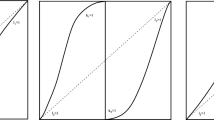Abstract.
The mountain-pass theorem guarantees the existence of a critical point on a path that connects two points separated by a sufficiently high barrier. We propose the elastic string algorithm for computing mountain passes in finite-dimensional problems and analyze the convergence properties and numerical performance of this algorithm for benchmark problems in chemistry and discretizations of infinite-dimensional variational problems. We show that any limit point of the elastic string algorithm is a path that crosses a critical point at which the Hessian matrix is not positive definite.
Similar content being viewed by others
References
Ambrosetti, A.: Elliptic equations with jumping nonlinearities. J. Math. Phys. Sci. 18, 1–12 (1984)
Ambrosetti, A., Rabinowitz, P.H.: Dual variational methods in critical point theory and applications. J. Funct. Anal. 14, 349–381 (1973)
Aubin, J.-P., Ekeland, I.: Applied Nonlinear Analysis. John Wiley & Sons, 1984
Bell, S., Crighton, J.S., Fletcher, R.: A new efficient method for locating saddle points. Chem. Phys. Lett. 82, 122–126 (1982)
Byrd, R., Hribar, M., Nocedal, J.: An interior point method for large scale nonlinear programming. SIAM J. Optim. 9, 877–900 (1999)
Caklovic, L., Li, S., Willem, M.: A note on Palais-Smale condition and coercivity. Diff. Integral Eqs. 3, 799–800 (1990)
Chen, G., Zhou, J., Ni, W.: Algorithms and visualization for solutions of nonlinear elliptic equations. Internat. J. Bifur. Chaos. 10, 1565–1612 (2000)
Choi, Y.S., McKenna, P.J.: A mountain pass method for the numerical solution of semilinar elliptic problems. Nonlinear Anal. 20, 417–437 (1993)
Ding, Z., Costa, D., Chen, G.: A high-linking algorithm for sign-changing solutions of semilinear elliptic equations. Nonlinear Anal. 38, 151–172 (1999)
Ekeland, I.: Convexity Methods in Hamiltonian Mechanics. Springer-Verlag, 1990
Fourer, R., Gay, D.M., Kernighan, B.W.: AMPL: A Modeling Language for Mathematical Programming. Duxbury Press, second ed., 2002
Henkelman, G., Jóhannesson, G., Jónsson, H.: Methods for finding saddle points and minimum energy paths. In: Progress in Theoretical Chemistry and Physics. S.D. Schwartz, (ed.), Vol. 5, Kluwer, 2000
Lawrence, C.T., Tits, A.L.: A computationally efficient feasible sequential quadratic programming algorithm. SIAM J. Optim. 11, 1092–1118 (2001)
Li, Y., Zhou, J.: A minimax method for finding multiple critical points and its applications to semilinear PDEs. SIAM J. Sci. Comput. 23, 840–865 (2001)
Li, Y., Zhou, J.: Convergence results of a local minimax method for finding multiple critical points. SIAM J. Sci. Comput. 24, 865–885 (2002)
Mawhin, J., Willem, M.: Critical Point Theory and Hamiltonian Systems. Springer-Verlag, 1989
National Research Council.: Mathematical Challenges from Theoretical and Computational Chemistry. National Academy Press, 1995
NEOS Server for Optimization Problems.: See www-neos.mcs.anl.gov
Struwe, M.: Variational Methods. Springer-Verlag, 2000
Vanderbei, R.J.: LOQO user’s manual – Version 3.10. Opt. Meth. Softw. 12, 485–514 (1999)
Willem, M.: Minimax Theorems. Birkäuser, 1996
Author information
Authors and Affiliations
Corresponding author
Additional information
This work was supported by the Mathematical, Information, and Computational Sciences Division subprogram of the Office of Advanced Scientific Computing Research, Office of Science, U.S. Department of Energy, under Contract W-31-109-Eng-38.
Rights and permissions
About this article
Cite this article
Moré, J., Munson, T. Computing mountain passes and transition states. Math. Program., Ser. B 100, 151–182 (2004). https://doi.org/10.1007/s10107-003-0489-0
Received:
Accepted:
Published:
Issue Date:
DOI: https://doi.org/10.1007/s10107-003-0489-0




